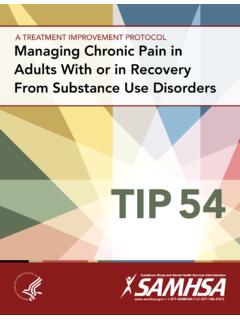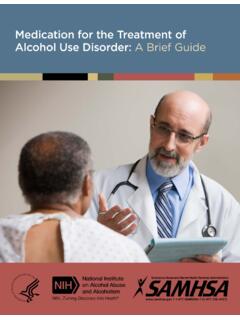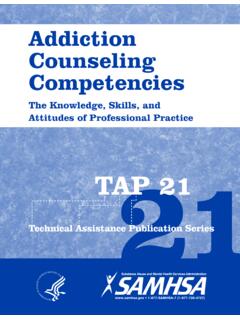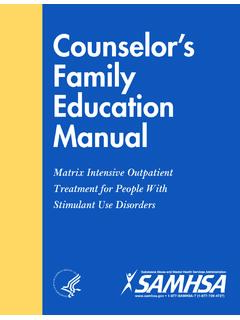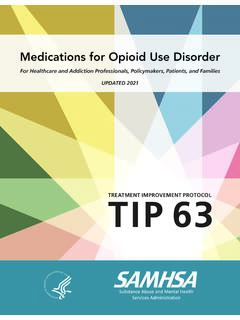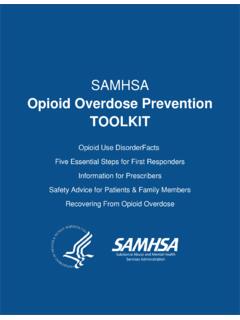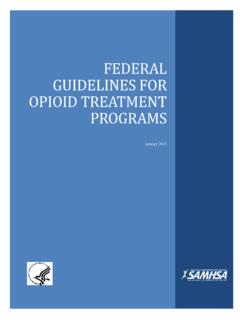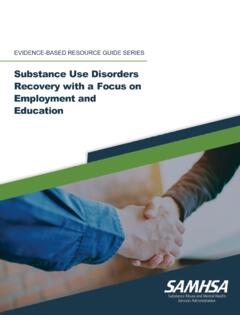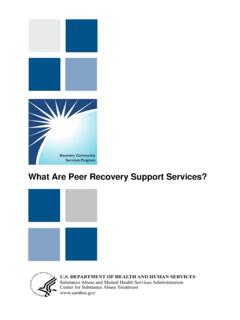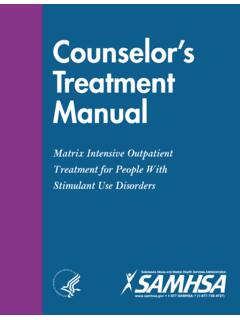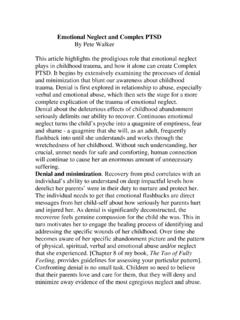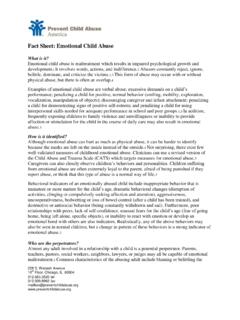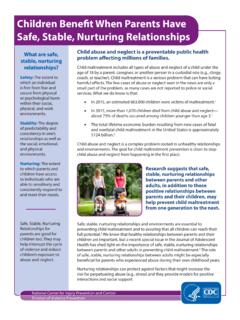Transcription of SAMHSA's Concept of Trauma and Guidance for a Trauma …
1 samhsa s Concept of Trauma and Guidance for a Trauma -Informed ApproachPrepared by samhsa s Trauma and Justice Strategic InitiativeJuly Department of Health and Human ServicesSubstance abuse and Mental Health Services AdministrationOffice of Policy, Planning and InnovationAcknowledgementsThis publication was developed under the leadership of samhsa s Trauma and Justice Strategic Initiative Workgroup: Larke N. Huang (lead), Rebecca Flatow, Tenly Biggs, Sara Afayee, Kelley Smith, Thomas Clark, and Mary Blake. Support was provided by samhsa s National Center for Trauma -Informed Care, contract number 270-13-0409. Mary Blake and Tenly Biggs serve as the CORs. DisclaimerThe views, opinions, and content of this publication are those of the authors and do not necessarily reflect the views, opinions, or policies of samhsa or Domain NoticeAll materials appearing in this volume except those taken directly from copyrighted sources are in the public domain and may be reproduced or copied without permission from samhsa or the authors.
2 Citation of the source is appreciated. However, this publication may not be reproduced or distributed for a fee without the specific, written authorization of the Office of Communications, samhsa , Department of Health and Human Access and Copies of PublicationThe publication may be downloaded or ordered from samhsa s Publications Ordering Web page at Or, please call samhsa at 1-877- samhsa -7 (1-877-726- 4727) (English and Espa ol).Recommended CitationSubstance abuse and Mental Health Services Administration. samhsa s Concept of Trauma and Guidance for a Trauma -Informed Approach. HHS Publication No. (SMA) 14-4884. Rockville, MD: Substance abuse and Mental Health Services Administration, OfficeOffice of Policy, Planning and Innovation, Substance abuse and Mental Health Services Administration, 1 Choke Cherry Road, Rockville, MD 20857. HHS Publication No. (SMA) 14-4884. Printed 1 ContentsIntroduction ..2 Purpose and Approach: Developing a Framework for Trauma and a Trauma -Informed Approach.
3 3 Background: Trauma Where We Are and How We Got Here ..5 samhsa s Concept of Trauma ..7 samhsa s Trauma -Informed Approach: Key Assumptions and Principles ..9 Guidance for Implementing a Trauma -Informed Approach ..12 Next Steps: Trauma in the Context of Community ..17 Conclusion ..17 Endnotes ..18page 2 IntroductionTrauma is a widespread, harmful and costly public supports and intervention, people can overcome health problem. It occurs as a result of violence, traumatic ,7,8,9 However, most people go abuse , neglect, loss, disaster, war and other without these services and supports. Unaddressed emotionally harmful experiences. Trauma has no Trauma significantly increases the risk of mental boundaries with regard to age, gender, socioeconomic and substance use disorders and chronic physical status, race, ethnicity, geography or sexual orientation. ,10,11It is an almost universal experience of people with mental and substance use disorders. The need to address Trauma is increasingly viewed as an important component of effective behavioral health service delivery.
4 Additionally, it has become evident that addressing Trauma requires a multi-pronged, multi-agency public health approach inclusive of public education and awareness, prevention and early identification, and effective Trauma -specific assessment and treatment. In order to maximize the impact of these efforts, they need to be provided in an organizational or community context that is Trauma -informed, that is, based on the knowledge and understanding of Trauma and its far-reaching effects of traumatic events place a heavy burden on individuals, families and communities and create challenges for public institutions and service systems. Although many people who experience a traumatic event will go on with their lives without lasting negative effects, others will have more difficulty and experience traumatic stress reactions. Emerging research has documented the relationships among exposure to traumatic events, impaired neurodevelopmental and immune systems responses and subsequent health risk behaviors resulting in chronic physical or behavioral health ,2,3,4,5 Research has also indicated that with appropriate With appropriate supports and intervention, people can overcome traumatic with experiences of Trauma are found in multiple service sectors, not just in behavioral health.
5 Studies of people in the juvenile and criminal justice system reveal high rates of mental and substance use disorders and personal histories of ,13 Children and families in the child welfare system similarly experience high rates of Trauma and associated behavioral health ,14 Young people bring their experiences of Trauma into the school systems, often interfering with their school success. And many patients in primary care similarly have significant Trauma histories which has an impact on their health and their responsiveness to health ,16,17In addition, the public institutions and service systems that are intended to provide services and supports to individuals are often themselves Trauma -inducing. The use of coercive practices, such as seclusion and restraints, in the behavioral health system; the abrupt removal of a child from an abusing family in the child welfare system; the use of invasive procedures in the medical system; the harsh disciplinary practices in educational/school systems; or intimidating practices in the criminal justice system can be re-traumatizing for individuals who already enter these systems with significant histories of Trauma .
6 These program or system practices and policies often interfere with achieving the desired outcomes in these systems. The need to address Trauma is increasingly viewed as an important component of effective behavioral health service delivery. page 3page 3 Thus, the pervasive and harmful impact of traumatic experienced by these individuals and how to mitigate events on individuals, families and communities and the re-traumatizing effect of many of our public the unintended but similarly widespread re-traumatizing institutions and service settings was not an integral of individuals within our public institutions and part of the work of these systems. Now, however, service systems, makes it necessary to rethink there is an increasing focus on the impact of Trauma doing business as usual. In public institutions and and how service systems may help to resolve or service systems, there is increasing recognition that exacerbate Trauma -related issues. These systems are many of the individuals have extensive histories of beginning to revisit how they conduct their business Trauma that, left unaddressed, can get in the way of under the framework of a Trauma -informed good health and well-being.
7 For example, a child who suffers from maltreatment or neglect in the home may not be able to concentrate on school work and be successful in school; a women victimized by domestic violence may have trouble performing in the work setting; a jail inmate repeatedly exposed to violence on the street may have difficulty refraining from retaliatory violence and re-offending; a sexually abused homeless youth may engage in self-injury and high risk behaviors to cope with the effects of sexual abuse ; and, a veteran may use substances to mask the traumatic memories of combat. The experiences of these individuals are compelling and, unfortunately, all too common. Yet, until recently, gaining a better understanding of how to address the Trauma There is an increasing focus on the impact of Trauma and how service systems may help to resolve or exacerbatetrauma-related issues. Thesesystems are beginning to revisit how they conduct their business under the framework of a Trauma -informed and Approach: Developing a Framework for Trauma and a Trauma -Informed ApproachPURPOSEThe purpose of this paper is to develop a working Concept of Trauma and a Trauma -informed approach and to develop a shared understanding of these concepts that would be acceptable and appropriate across an array of service systems and stakeholder groups.
8 samhsa puts forth a framework for the behavioral health specialty sectors, that can be adapted to other sectors such as child welfare, education, criminal and juvenile justice, primary health care, the military and other settings that have the potential to ease or exacerbate an individual s capacity to cope with traumatic experiences. In fact, many people with behavioral health problems receive treatment and services in these non-specialty behavioral health systems. samhsa intends this framework be relevant to its federal partners and their state and local system counterparts and to practitioners, researchers, and Trauma survivors, families and communities. The desired goal is to build a framework that helps systems talk to each other, to understand better the connections between Trauma and behavioral health issues, and to guide systems to become Trauma -informed. APPROACHSAMHSA approached this task by integrating three significant threads of work: Trauma focused research work; practice-generated knowledge about Trauma interventions; and the lessons articulated by survivors page 4of traumatic experiences who have had involvement in multiple service sectors.
9 It was expected that this blending of the research, practice and survivor knowledge would generate a framework for improving the capacity of our service systems and public institutions to better address the Trauma -related issues of their constituents. To begin this work, samhsa conducted an environmental scan of Trauma definitions and models of Trauma informed care. samhsa convened a group of national experts who had done extensive work in this area. This included Trauma survivors who had been recipients of care in multiple service system; practitioners from an array of fields, who had experience in Trauma treatment; researchers whose work focused on Trauma and the development of Trauma -specific interventions; and policymakers in the field of behavioral health. From this meeting, samhsa developed a working document summarizing the discussions among these experts. The document was then vetted among federal agencies that conduct work in the field of Trauma .
10 Simultaneously, it was placed on a samhsa website for public comment. Federal agency experts provided rich comments and suggestions; the public comment site drew just over 2,000 respondents and 20,000 comments or endorsements of others comments. samhsa reviewed all of these comments, made revisions to the document and developed the framework and Guidance presented in this key questions addressed in this paper are: What do we mean by Trauma ? What do we mean by a Trauma -informed approach? What are the key principles of a Trauma -informed approach? What is the suggested Guidance for implementing a Trauma -informed approach? How do we understand Trauma in the context of community? samhsa s approach to this task has been an attempt to integrate knowledge developed through research and clinical practice with the voices of Trauma survivors. This also included experts funded through samhsa s Trauma -focused grants and initiatives, such as samhsa s National Child Traumatic Stress Initiative, samhsa s National Center for Trauma Informed Care, and data and lessons learned from other grant programs that did not have a primary focus on Trauma but included significant attention to Trauma , such as samhsa s: Jail Diversion Trauma Recovery grant program; Children s Mental Health Initiative; Women, Children and Family Substance abuse Treatment Program; and Offender Reentry and Adult Treatment Drug Court Programs.
